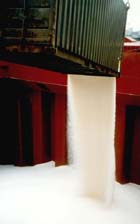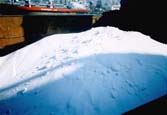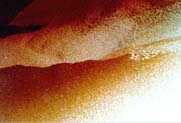Loading fertilizer in bulk (urea, ammonium nitrate, ammonium sulphate, saltpeter, etc.) at Novorossiysk and Tuapse ports
We
consider it very important to describe the method of loading of such cargoes at
Novorossiysk and the highlight possible difficulties, which Master may encounter
during loading operations.
 Usually
the cargo is delivered to the port in 20’’ containers on open railway
platforms. During transportation the containers are exposed to adverse weather
conditions and sometimes, due to unwatertightness of containers’ upper doors
its contents can be wetted.
Usually
the cargo is delivered to the port in 20’’ containers on open railway
platforms. During transportation the containers are exposed to adverse weather
conditions and sometimes, due to unwatertightness of containers’ upper doors
its contents can be wetted.
 Loading
is carried out by means of shore cranes, the container’s doors are opened when
the container is transferred above the opened cargo holds and the cargo spills
out into the vessel’s hold. Such procedure doesn’t give any opportunity for
the Master or Deck Officers to ascertain the cargo condition ashore before its
loading on board the vessel. This
leads to loading of damaged cargo on board the vessel, lumpy/caked, contaminated
with foreign admixtures or wetted.
Loading
is carried out by means of shore cranes, the container’s doors are opened when
the container is transferred above the opened cargo holds and the cargo spills
out into the vessel’s hold. Such procedure doesn’t give any opportunity for
the Master or Deck Officers to ascertain the cargo condition ashore before its
loading on board the vessel. This
leads to loading of damaged cargo on board the vessel, lumpy/caked, contaminated
with foreign admixtures or wetted.
The
circumstances worsening the master’s position are as follows :
Usually
terms of Charter Parties require from the Master to reject all damaged cargo and
issue a «clean on board» Bill of Lading. The root of the problem experienced
by the Master is that the bad cargo condition becomes visible inside ship’s
holds only after discharging from the containers.
Moreover,
before the vessel’s arrival the cargo is accumulated near the port territory
and it is very important to note that in case the scheduled quantity cargo has
not arrived yet at the port the surveyors acting on behalf of the cargo shipper
are trying to reject the holds’ readiness for loading to gain time. So, we
assume, it’s necessary to arrange holds inspection on the part of the vessel
to check their readiness for commencement of loading.
Below pictures demonstrate the most frequently discovered kinds of damage to the cargo condition:
 Caking
Caking
 Wetting
Wetting

Contamination with foreign admixtures

If any damaged cargo is found our surveyors assist the Master in arranging removing of the contaminated cargo or, if the above is rejected, we recommend the Master to clause the Mates' Receipts and Bills of Lading with the corresponding remarks.
Taking
the above into account, we think, it is most important that on the part of the
vessel draft survey, inspection of vessel’s hatches/holds and the cargo
condition survey would be performed. The above is within the scope of the services
provided by our company. Moreover, our surveyor may render assistance to the
Master in rejecting the damaged cargo and in proper clausing of Mate’s
Receipts and Bills of Lading.
Recently a new export terminal for loading bulk fertilizers has been put into operation at No.5 pier of the Eastern Dock of Novorossiysk port. The new facility includes the railcar unloading station, belt conveyer gallery and shiploader. The terminal accommodates vessels with a maximum draft up to 13 miters and the rate of loading for the terminal is up to 600 tons per hour. At the current stage the terminal will specialize in loading the Nitrates (N), Nitroamaphos (NP) and NPK fertilizers.
In
the port of Tuapse this cargo is also loaded but with application of a different
method of loading - loading is performed with shore crane grabs from open box
cars.